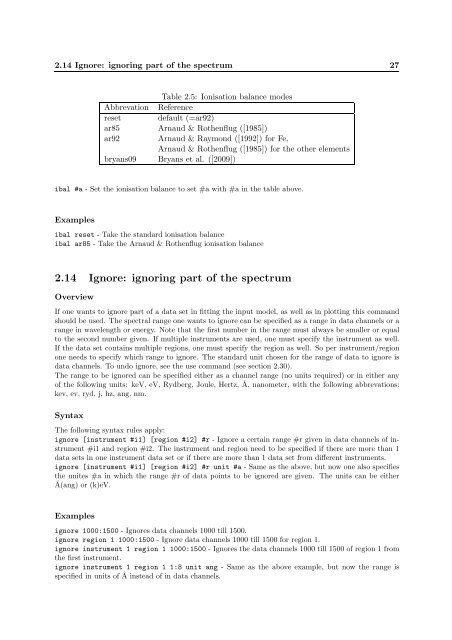SPEX Reference manual (PDF) - SRON
SPEX Reference manual (PDF) - SRON
SPEX Reference manual (PDF) - SRON
Create successful ePaper yourself
Turn your PDF publications into a flip-book with our unique Google optimized e-Paper software.
2.14 Ignore: ignoring part of the spectrum 27<br />
Table 2.5: Ionisation balance modes<br />
Abbrevation <strong>Reference</strong><br />
reset default (=ar92)<br />
ar85 Arnaud & Rothenflug ([1985])<br />
ar92 Arnaud & Raymond ([1992]) for Fe,<br />
Arnaud & Rothenflug ([1985]) for the other elements<br />
bryans09 Bryans et al. ([2009])<br />
ibal #a - Set the ionisation balance to set #a with #a in the table above.<br />
Examples<br />
ibal reset - Take the standard ionisation balance<br />
ibal ar85 - Take the Arnaud & Rothenflug ionisation balance<br />
2.14 Ignore: ignoring part of the spectrum<br />
Overview<br />
If one wants to ignore part of a data set in fitting the input model, as well as in plotting this command<br />
should be used. The spectral range one wants to ignore can be specified as a range in data channels or a<br />
range in wavelength or energy. Note that the first number in the range must always be smaller or equal<br />
to the second number given. If multiple instruments are used, one must specify the instrument as well.<br />
If the data set contains multiple regions, one must specify the region as well. So per instrument/region<br />
one needs to specify which range to ignore. The standard unit chosen for the range of data to ignore is<br />
data channels. To undo ignore, see the use command (see section 2.30).<br />
The range to be ignored can be specified either as a channel range (no units required) or in either any<br />
of the following units: keV, eV, Rydberg, Joule, Hertz, Å, nanometer, with the following abbrevations:<br />
kev, ev, ryd, j, hz, ang, nm.<br />
Syntax<br />
The following syntax rules apply:<br />
ignore [instrument #i1] [region #i2] #r - Ignore a certain range #r given in data channels of instrument<br />
#i1 and region #i2. The instrument and region need to be specified if there are more than 1<br />
data sets in one instrument data set or if there are more than 1 data set from different instruments.<br />
ignore [instrument #i1] [region #i2] #r unit #a - Same as the above, but now one also specifies<br />
the unites #a in which the range #r of data points to be ignored are given. The units can be either<br />
Å(ang) or (k)eV.<br />
Examples<br />
ignore 1000:1500 - Ignores data channels 1000 till 1500.<br />
ignore region 1 1000:1500 - Ignore data channels 1000 till 1500 for region 1.<br />
ignore instrument 1 region 1 1000:1500 - Ignores the data channels 1000 till 1500 of region 1 from<br />
the first instrument.<br />
ignore instrument 1 region 1 1:8 unit ang - Same as the above example, but now the range is<br />
specified in units of Å instead of in data channels.

















